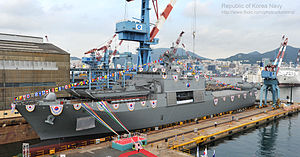Cheon Wang Bong-class tank landing ship

| |
| Class overview | |
|---|---|
| Name | Cheon Wang Bong class |
| Builders | Hanjin Heavy Industries, Hyundai Heavy Industries |
| Operators | |
| Built | 2014 - |
| In service | 2014 - present |
| In commission | 2014 - present |
| Planned | 4 |
| Building | 3 |
| Completed | 1 |
| Active | 1 |
| General characteristics | |
| Type | Landing Ship, Tank |
| Tonnage | 4,950 tons (empty) / 7,140 tons (full) |
| Length | 126.9 m (416 ft) |
| Beam | 19.4 m (64 ft) |
| Draught | 5.4 m (18 ft) |
| Installed power | 12,800 hp (9,500 kW) |
| Propulsion | CODAD, 4 × MAN 12V28/33D STC diesel engines rated at 5460 kW, 4 x 6L21/31 auxiliary engines rated 1,200 kW [1] |
| Speed |
|
| Range | 8,000 nmi (15,000 km; 9,200 mi) |
| Boats & landing craft carried | 2 x LCM |
| Troops | 700 |
| Crew | 120 |
| Sensors and processing systems | |
| Armament | 1 × Hanwha Defense Systems (formerly Doosan DST) 'No Bong' dual 40mm gun, 2 x K-VLS |
| Armor | LIG Nex1 SLQ-200K Sonata electronic warfare suite, Rheinmetall MASS decoy system[2] |
| Aviation facilities | Aft helicopter deck |
The Cheon Wang Bong-class LST (Hangul:천왕봉) is an amphibious landing ship class of the Republic of Korea Navy.
Development
In the late 1980s the Republic of Korea Navy decided to gradually replace its aging fleet of World War II-era Template:Sclass- LSTs (renamed Un Bong-class LST)purchased from the US Navy in 1958. A three phase plan was laid out to develop new landing ships to meet the demands of modern amphibious and transport operations.
The first phase was designated as the LST-I project, and development and design started in 1987 by Korea Tacoma, currently Hanjin Heavy Industries. After 4 years of development, the lead ship Go Jun Bong (LST 681) was launched in 1991. Three more ships followed and all four ships were commissioned by 1998.
The second phase, or LST-II, was originally planned to import four Template:Sclass-s, but after being postponed due to budget issues, it was changed in favor for domestic built 4500-ton LPDs to be commissioned by 2013-2016.[3] After the construction of the first vessel, a follow-on contract for four additional vessels were awarded to Hyundai Heavy Industries in December 2013.[4]
Ships in the class
| Name | Pennant number | Builder | Launched | Commissioned | Decommissioned | Status |
|---|---|---|---|---|---|---|
| ROKS Cheon Wang Bong | LST-686 | Hanjin Heavy Industries | 11 September 2013 | 1 December 2014 | Active | |
| ROKS Cheon Ja Bong | LST-687 | Hyundai Heavy Industries | 15 December 2015 | 2016 (Expected) | Launched | |
| ROKS Il Chul Bong | LST-688 | Hyundai Heavy Industries | 25 October 2016 | Launched | ||
| TBD | LST-689 | Hyundai Heavy Industries |
References
- ^ "Archived copy". Archived from the original on 2016-03-04. Retrieved 2015-01-18.
{{cite web}}: Unknown parameter|deadurl=ignored (|url-status=suggested) (help)CS1 maint: archived copy as title (link) - ^ http://www.navyrecognition.com/index.php/news/defence-news/year-2012-news/april/448-rheinmetall-receives-order-from-south-korea-mass-naval-countermeasures-system-for-lst-ii-class.html
- ^ Chosun Daily - 4천500t급 차기상륙함 윤곽 드러나 10/9/2007
- ^ http://english.yonhapnews.co.kr/full/2013/12/26/24/1200000000AEN20131226004800315F.html
